|
Big Bang Experiment Ready To Go
May 25 2008
Greg
Milam
Europe correspondent
The
world's biggest scientific experiment is set for
the big switch-on within weeks - and it could
answer some of the biggest questions in the
universe.
Thousands
of scientists have spent more than a decade
building the Large Hadron Collider at the
European Centre For Nuclear Research in Geneva.
By smashing atoms
together, the machine will recreate the
conditions just after the 'Big Bang' when the
universe was created.
British
scientist Mike Lamont, who helped build the
experiment, told Sky News: "By going back in
time, by recreating, we're exploring the
physics, the way the universe unfolded in those
first few instances of time.
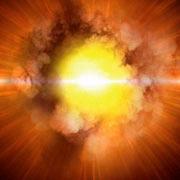
Experiment will re-create Big Bang
Thousands of scientists
have spent more than a
decade building the
Large Hadron Collider at
the European Centre For
Nuclear Research in
Geneva.
By smashing atoms
together, the machine
will recreate the
conditions just after
the 'Big Bang' when the
universe was created.
British scientist Mike
Lamont, who helped build
the experiment, told Sky
News: "By going back in
time, by recreating,
we're exploring the
physics, the way the
universe unfolded in
those first few
instances of time.
"It is just part of this
adventure of man pushing
at the limits."
The machinery is housed
in a 17 mile tunnel 100
metres beneath
Switzerland and France.
Atoms will race around
at virtually the speed
of light in an
atmosphere colder than
outer space.
The millions of
collisions will create
temperatures 100,000
times hotter than the
sun.
Scientists hope that
will uncover secrets
about the universe's
structure and reveal
more about dark matter.
They also believe the
experiment could confirm
the existence of the
so-called 'Higgs Boson',
dubbed the 'God
Particle', which would
explain why some
particles have differing
mass.
The theory is named
after British scientist
Peter Higgs, who
developed it in 1964,
but no-one has ever seen
the particle.
Professor Higgs said:
"I've asked my GP to
keep me alive a little
longer."
Scientists have also
dismissed claims that
the experiment will
create black holes to
swallow up the planet.
Physicist Dr Pippa Wells
said: "In the universe
at the moment the stars
we see don't explain how
the stars and galaxies
move around each other.
There must be more
'stuff' out there."
The CERN site is the
setting for the Dan
Brown novel Angels and
Demons and scenes for
the movie version are
being filmed there.
And if the experiment
doesn't work? "We will
have assembled the
world's most expensive
piece of modern art,"
says one scientist.
Source
http://news.sky.com/skynews/article/0,,91221-1315292,00.html
Bottling the big bang
The air of anticipation around CERN, the European
Organisation for Nuclear Research near
Geneva, is palpable. In a matter of
weeks, the world's most powerful
particle accelerator, the Large Hadron
Collider (LHC), will start operating,
hurling subatomic particles around its
27km circumference at almost the speed
of light. Two months later, the two
contra-rotating beams will be squeezed,
focused and aimed at each other to
collide with colossal force, creating
conditions that existed millionths of a
second after the Big Bang.
The physics goals of the LHC are
mind-boggling. Discovering the Higgs
boson, the particle that explains the
origins of mass; explaining why the
universe is made of matter not
anti-matter; freeing the constituent
parts of the particles that make up the
nuclei of atoms; possibly making minute
black holes which, in passing, would
indicate that alternate dimensions
exist. But in order to answer these
questions, equally mind-blowing
engineering has been brought into play,
100m below the ground in the tunnels and
caverns that make up the LHC complex.
The project has several parts. There is
the LHC itself, one of a series of
particle accelerators at CERN and the
final link in a chain that takes charged
particles — protons or lead nuclei —
from a standing start to 99.999999 per
cent of the speed of light. Then there
are the detectors that observe what
happens when the particles collide.
There are four major detectors: ATLAS (A
Toroidal LHC Apparatus) and CMS (Compact
Muon Solenoid), which sit opposite each
other on the LHC circuit, aim to observe
every particle resulting from the
collisions; ALICE (A Large Ion Collider
Experiment) and LHCb are looking for
specific phenomena. Associated with
these are a raft of ancillary services,
including control systems and an
enormous computing effort to collate and
study the data from the experiments.
The scale of everything is stunning.
Even before it starts, LHC is already
producing superlatives. The largest
magnets ever made. The biggest
deployment of superconducting
technology. The most powerful network of
computers. The lowest temperatures. The
highest speeds.
From the surface, it is hard to
comprehend the size of CERN. Its
headquarters are just outside Geneva and
look much like any other university. But
there is no indication of the
whereabouts of the ring of the LHC,
longer and deeper than London's
Underground's Circle Line (and more
circular) and crossing the Swiss-French
border four times.
CMS, the most distant of the experiments
from the headquarters, is a 20-minute
drive into the mountains from ATLAS,
which is the only one of the four
detectors in Switzerland. ALICE's
surface buildings sit incongruously next
to a pretty village; LHCb is behind a
supermarket near Geneva airport, just
within France.
Visiting CERN is a jaw-dropping
experience. ATLAS, the larger of the two
general detectors, is half the size of
Notre Dame cathedral, a glittering chunk
of technology 44m long, 22m high and
weighing 7,000 tonnes; it is like
standing next to a cliff covered in gold
mirror. CMS, 15m across and 22m long, is
even heavier at 12,000 tonnes; it
resembles a planet-busting superweapon
from a science fiction film.
Compared with these monsters, the LHC
itself seems relatively modest. Its
tunnel was one of the few parts of the
project not purpose-built; it housed the
site's previous high-energy particle
accelerator, the Large Electron-Positron
collider (LEP), which operated from 1989
to 2000. Without the site's other
accelerators, it would be useless.
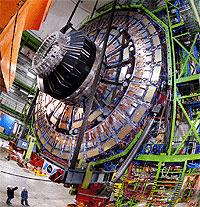
An endcap of CMS is lowered down
into its cavern
LHC works
with protons most of the time, and these
start off in a bottle of hydrogen.
Stripping away the electrons produces
the isolated protons, and 'bunches' of
these, containing about 1011 particles,
are injected by a linear accelerator
into the first of CERN's circular
accelerators or synchrotrons, the PS
Booster, which accelerates them to
1.4GeV. They are then transferred to
another accelerator, the Proton
Synchrotron, which increases their
energy to 25GeV; then on to the Super
Proton Synchrotron (SPS), which
accelerates them to 450GeV. The SPS has
two branches to transfer bunches to the
LHC, one to the clockwise circuit, one
anticlockwise. LHC accelerates the
protons to 7TeV, roughly equivalent to
the kinetic energy of a flying mosquito,
but far more concentrated.
Before LHC was built, all the
accelerators had independent control
systems but now, to aid co-ordination of
the accelerators and their supporting
power and cooling grids, all the systems
are operated from a single,
purpose-built control centre. It is a
haven of blue-carpeted calm where
cataclysmic forces are marshalled and
focused. 'We can have 50 or 60 people in
here and it still feels quiet,' said
Paul Collier, one of the LHC engineers.
The beams run for most of their circuit
through two separate pipes about 20cm
across, which are under a high vacuum of
10-13 atm.
At regular intervals, the beams pass
through radiofrequency cavities, which
pump power in to accelerate the
particles, and a series of magnets that
generate a field of 8.3T (for
comparison, the Earth's magnetic field
is about 40mT at the surface), steering
the protons around their near-circular
orbit.
The amount of current needed to maintain
the field is huge, some 11,700A, so the
magnets are superconducting; they are
made from strands of a niobium/titanium
alloy. When cooled to below 10K, this
material conducts electricity with zero
resistance. In the LHC magnets, the
cables are cooled by liquid helium at
2.7K. At this temperature, helium is in
a state known as a superfluid, which
allows it to conduct a large amount of
heat and therefore makes it an extremely
efficient refrigerant.
The superconductivity is essential to
reduce the amount of electricity needed
to run the magnets. 'Even so, we use
about 30 per cent of the electricity
demand of the Canton of Geneva,' said
LHC physicist Mike Lamont.
The total power consumption of the LHC
alone is 120MW, with CERN as a whole
consuming 230MW. 'That's one of the
advantages of being in both France and
Switzerland. The Swiss Grid alone can't
supply all the electricity we need; we
actually get most of it from France.
Even then, glitches in the power supply
cause major problems —the system can
take weeks to settle down properly after
a glitch. We have a large amount of
power conditioning to make sure the
supply is smooth, but we can still have
problems.'
There are several types of magnet used
on the LHC. Most of them are dipoles,
but immediately before the beams enter
the caverns housing the detectors, they
run through a more complex type of
magnet called a quadrupole. These
squeeze the diameter of the proton bunch
down from about a millimetre to about
16µm and aim it so that it will collide
with the beam travelling in the opposite
direction from the other side of the
detector. 'Despite the number of protons
in a bunch, only about 20 per bunch will
actually collide with another proton;
the others will just fly through without
noticing anything,' said Lamont.
Each bunch is about 7m apart, which
means bunches will cross 30 million
times every second; in other words,
there will be 600 million particle
collisions a second.
Like any high-energy synchrotron, the
LHC will be dangerous when running.
Beams of particles at near-light speed
give off radiation similar to X-rays, so
in operation, nobody will be allowed
inside the LHC tunnel, or the detector
caverns. 'I don't know how long it would
take you to die,' said Lamont. 'But
you'd die.'
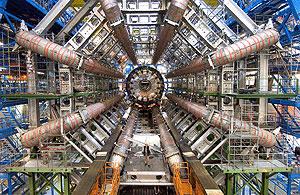
The superconducting coils of the
toroidal magnet system, striped in red,
awaiting the arrival of the inner
detectors and solenoid
The
consequences of colliding two protons
with energies of 7TeV are dramatic. The
energy — much less than that produced by
a handclap, but focused down to an
almost imaginably small size — is enough
to break the particles apart and
recombine the fragments into a variety
of different particles. Many of these
can only exist in the hot, dense
conditions immediately following the
collision: conditions similar to those
just after the Big Bang. It is the job
of the detectors to see and categorise
these particles, and they have a variety
of ways to do it.
ATLAS and CMS, the two 'general-purpose'
detectors on the LHC, are both designed
to do the same physics: detect all the
particles produced during collisions,
and reconstruct the processes that made
them. Two detectors are necessary, so
that each can confirm the findings of
the other, but there is a certain amount
of rivalry between ATLAS and CMS that
pervades CERN.
'We come from different schools of
physics, and we have very different
ideas, but both groups believe they have
the right answer,' said Marzio Nessi,
technical director at ATLAS. 'Whoever
sees the Higgs boson, for example, first
— they'll be the ones to get the Nobel
Prize.'
All the detectors work in roughly the
same way, and ATLAS, CMS and ALICE have
similar designs. The detectors are
barrel-shaped, with large magnets
wrapped around the collision point. When
charged particles fly out of the
collision, the magnetic field makes them
follow a curved trajectory — positive
charges in one direction, negative in
the other. Vast arrays of detectors,
containing materials that ionise when
charged particles pass through them,
track the paths of the particles through
the detector. Particles with high
momentum will curve very little, low
momentum ones will fly in tight spirals.
The particles end up in calorimeters,
which measure the energy of the particle
by stopping it dead. There are two types
— electromagnetic calorimeters (ECALs),
which work on particles such as
electrons and photons that do not
interact much with matter; and hadronic
calorimeters (HCALs), for particles such
as protons and neutrons. Generally,
these use materials that can convert the
kinetic energy of the particles into
light or an electric signal, that can be
collected and analysed.
The only particles that can pass through
both types of detector are muons, which
are similar to electrons. It is vital to
detect these, as they are produced when
some of the particles that CERN is
particularly looking for decay; for
example, theory predicts that a Higgs
boson will decay into four muons. All
the LHC detectors therefore have
specific systems for finding muons,
which are often the most impressive and
largest part of the system.
It is obvious from looking at ATLAS and
CMS that their technologies are
different. ATLAS is characterised by the
arrangement of its magnetic fields. The
inner parts of the mammoth detector are
surrounded by a solenoid coil, which
bends the paths of all particles apart
from muons. This is surrounded by a
toroidal field shaped like an
exceptionally deep ring doughnut and
generated by eight superconducting
loops, which run the full length of the
detector; the largest superconducting
magnets ever constructed (although they
will be overtaken by the magnets at
ITER, the nuclear fusion reactor soon to
take shape in southern France). Within
this magnetic field are the systems to
track and stop the muons. At either end
of the barrel are 'big wheels', huge
discs of muon detectors to stop the
particles that fly forwards from the
collision.
'There are 2,000 scientists working on
this project, and every single one of
them would die to see it completed,'
said Nessi. 'They speak over 30
different languages and come from over
160 institutions, but we've found ways
to communicate and work and bring these
systems together. You just don't get
that level of devotion on most
engineering projects.'
Integrating the systems has been a
particularly difficult task, he added:
'All these thousands of detectors need
to be cooled, so they all have their
little circuits to carry liquid helium
or argon to them; and they are all
linked to the data-gathering system via
fibre-optics.'
CMS, meanwhile, has only a solenoid
magnet surrounding the trackers, ECAL
and HCAL systems, but it is the largest
superconducting solenoid ever built, a
13m long, 6m diameter coil of
niobium-titanium, producing a 4T
magnetic field.
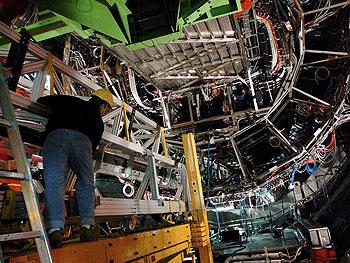
A technician slides the final rack
of detectors into the support structure
of the ALICE experiment
The ECAL of
CMS is particularly unusual, containing
80,000 crystals of lead tungstate,
denser than iron but transparent and
made in China and Russia. When electrons
and photons pass through these crystals,
they produce a flash of light which can
be amplified and analysed to determine
the energy of the particles. The immense
weight of the crystals is supported in a
fibreglass construction structured like
the inside of the human lung, with
separate 'alveoli' or pockets for each
crystal.
Building CMS was a particularly tricky
task, said civil engineer John Osborne,
because of its location. 'We're near the
mountains, so we had to dig through 80m
of glacial deposits before we got to
solid rock to make the cavern,' he said.
'So while ATLAS was built entirely
within its cavern, CMS was built on the
surface while we did the excavation,
tested there, then lowered into the
cavern in slices.'
To dig the cavern, Osborne's team sunk a
series of tubes through the
water-saturated glacial deposits and
filled them with a freezing mixture,
cold enough to freeze the water
surrounding the tubes and create a
curtain of ice.
They then dug the 100m deep pit through
which the CMS slices would be lowered,
while the ice held back the water in the
surrounding rock. Once the sides of the
pit were lined with cement, the ice
curtain was left to melt, and the team
continued excavating horizontally to
complete the cavern.
While ATLAS and CMS are general
detectors, ALICE is specialised, looking
at a different sort of collision. For
most of its operational period (270 days
a year), LHC will accelerate protons.
But for the remaining time, its circuit
will be filled by nuclei from lead atoms
—more than 200 times heavier than a
proton, and far more complex in
structure, containing both protons and
neutrons. Because their mass is greater,
their momentum and therefore their
collision energy is also higher, and
they produce a much greater variety of
particles.
The ALICE physicists hope that the hot,
dense conditions at the collision point
will melt the protons and neutrons into
their component parts, charged particles
called quarks, and gluons, which carry
the force that holds the quarks
together. Physicists believe that in the
microseconds after the Big Bang, a
plasma of quarks and gluons existed
which then coalesced into normal matter.
Quarks are not found alone in nature,
but nobody knows why. Moreover, protons
and neutrons contain three quarks, but
the mass of three quarks is only 1 per
cent of the mass of either particle, and
gluons have no mass. There is a theory
that the mechanism that forces the
particles together may give rise to the
rest of the mass, and ALICE might be
able to confirm this.
ALICE also contains a solenoid, but it
is not superconducting. Instead, it is
made of iron — it contains as much iron
as the Eiffel Tower — and is
second-hand; it was used on the LEP
experiment in the same cavern. Its 77
tonnes of detectors are slid into the
barrel of the magnet into a stainless
steel support structure on trolleys,
which allows them to be removed easily
for maintenance during the LHC's winter
shutdown (electricity is prohibitively
expensive around Geneva in the winter).
This, says Diego Perrini, who is
responsible for ALICE's support
structures, illustrates an important
difference between the detectors and the
LHC itself. 'We can run ALICE with
missing detectors; it just means we
won't get any data from that particular
sector,' he said. 'But all the LHC
systems have to be functional for
anything to work.'
The exception to the barrel design is
LHCb, which is looking for specific
objects known as B-particles. These
contain a type of subatomic particle
called a b-quark (also known as a bottom
quark or a beauty quark), which is not
stable under normal conditions. Studying
them will help understand why the
universe is made of matter, not
antimatter.
B-particles are only scattered in a
shallow angle from the main beam, so
LHCb's detectors are arrayed around and
in front of the collision point like a
series of walls.
LHCb contains some of the most
specialised detectors in CERN, because
it needs to locate the position of the
particle collisions with more precision
than any of the other experiments.
'B-particles are very unstable and decay
only a millimetre away from the
collision that produced them,' said
Richard Jacobsson, an LHCb physicist.
'LHCb has to be able to confirm whether
it is detecting particles that come from
the collision, or from a 'secondary
vertex' a short distance away, which
would indicate the presence of a
B-particle.'
It does this with a detector called the
VELO (VErtex LOcator), which is the
closest detector to a collision point
anywhere in CERN, just 5mm away from the
intersecting beams, which have energy
similar to a high-speed train.
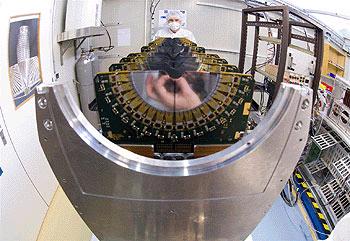
Half of the VELO array for the LHCb
detector, which locates the position of
collisions precisely
The VELO
consists of 42 semicircular modules that
sit on either side of the collision
point and close in to study the
collision. Made from silicon that
produces an electrical signal when
struck by a particle, they were built in
the UK, at the University
of Liverpool.
Much of the engineering at CERN is in
fact done by physicists, Jacobssen said.
'It puts us in an interesting position,
because nobody has done anything like
this before,' he said.
A large sheet of expanded polystyrene
taped to one of the scintillation
counters on LHCb testifies to the tricky
nature of the work.
'Somebody put three holes in the
casing,' said Jacobsson. 'We're not sure
how.' Then there was a loud clang and a
shout of 'Desolé!' 'I think that might
be a fourth,' said Jacobsson.
Back on ATLAS, Nessi believes that
typical engineering skills could be the
key to the whole project.
'We've all had to learn to work in
cross-disciplinary ways; we've learned
new jobs, new skills, and worked with an
array of people we couldn't have
imagined. And the ones who are best at
the collaborations? They're the ones who
will make the big discoveries. The ones
who'll win.'
Source
http://www.theengineer.co.uk/Articles/306218/Bottling+the+big+bang.htm
1 2 3 4 5 6 7 8 9 10 Newest
articles
|
